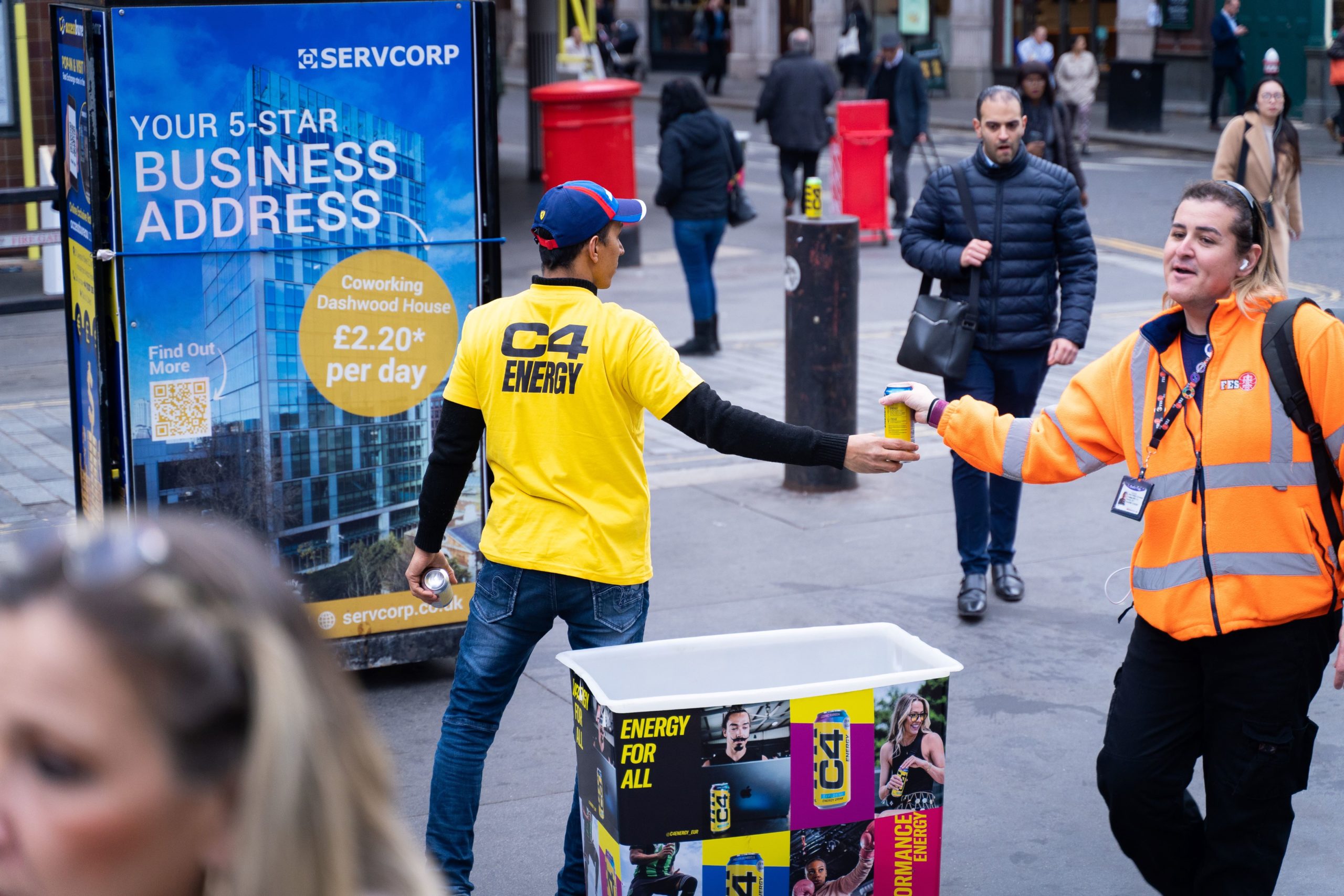In today’s highly competitive business landscape, building a strong brand is essential for success. However, creating a brand is not enough; you must also activate it effectively to make it resonate with your target audience. Brand activation is the process of bringing a brand to life, engaging consumers, and forging a deeper connection between your brand and your customers.
In this article, we’ll delve into the diverse world of brand activation, exploring various types and marketing strategies that businesses can employ to enhance their brand presence and resonate with their audience.
What is Brand Activation?
If you’re wondering what this marketing buzzword really means, brand activation is a brand marketing strategy that aims to create a memorable and lasting impact on consumers through real-life experiences.
It is a concept rather than a set of marketing steps, much like brand awareness or marketing itself.
Brand activation involves things like activities and campaigns designed to introduce or reintroduce a brand to its target audience and encourage them to interact with it. The goal of brand activation is to turn passive consumers into active brand advocates.
You’ve got plenty of options to kickstart or freshen your brand, so you won’t run out of ideas for brand activation. If you would like to hear about how Relish can help you with your brand activation, drop us a message or give us a call on 01173751160. Alternatively, send us an email at team@relishagency.com
6 Key Components of Brand Activation Campaigns
Whether you’re a seasoned marketer or just dipping your toes into the world of branding, understanding these key elements of brand activation is crucial to turning your brand into a living, breathing entity that captures hearts and minds.
1. Understanding Your Brand:
Before you can activate your brand, you need to have a clear understanding of what your brand stands for, its values, mission, and unique selling points. This forms the foundation for all brand activation efforts.
2. Identifying Your Target Audience:
To effectively activate your brand, you must know who your ideal customers are. Conduct market research to understand their preferences, behaviours, and needs. This information will help you tailor your activation strategies to resonate with your audience.
3. Creating Engaging Experiences:
Brand activation often involves creating immersive experiences that connect consumers with your brand. This can take various forms, such as events, product launches, pop-up shops, or interactive digital campaigns. The goal is to make your brand memorable and create a personal connection with your audience.
4. Leveraging Social Media:
In the digital age, social media is a powerful tool for brand activation. Use platforms like Facebook, Instagram, Twitter, and TikTok to engage with your audience, share content, and run campaigns encouraging user participation and sharing.
5. Consistency and Coherence:
Your brand activation efforts should align with your overall brand identity. Consistency in messaging, visuals, and tone is crucial to building trust and recognition with your audience.
6. Measuring Success:
To evaluate the effectiveness of your brand activation efforts, establish key performance indicators (KPIs) such as website traffic, social media engagement, sales, or brand sentiment. Regularly measure and analyse these metrics to refine your strategy.
Types of Brand Activation
Experiential marketing
Experiential Marketing, also known as engagement marketing or event marketing, is a dynamic and immersive marketing strategy that focuses on creating memorable, hands-on experiences for consumers. It goes beyond traditional advertising methods by inviting individuals to interact directly with a brand’s products, services, or messages.
Experiential marketing campaigns aim to forge a deep and emotional connection between the brand and its audience, leaving a lasting impression and generating positive word-of-mouth marketing.
Whether through interactive events, pop-up shops, product demonstrations, or live activations, experiential marketing seeks to engage all the senses, offering consumers a chance to not just learn about a brand but to personally engage with it, fostering brand loyalty and customer advocacy in the process.
Product Sampling
Product sampling is a highly effective form of brand activation that revolves around offering potential customers a tangible experience with a product. It allows consumers to try a brand’s offerings firsthand, often free of charge or at a reduced cost. This hands-on experience is a powerful way to build trust and confidence in a brand, as it allows customers to evaluate the quality and value of a product before making a purchase.
Product sampling can take various forms, such as distributing samples in-store, at events, through mail, or via digital platforms. It not only introduces the product to a wider audience but also creates a memorable and positive association with the brand, encouraging word-of-mouth recommendations and driving conversions.
Successful product sampling campaigns can boost brand awareness, drive sales, and create lasting connections between consumers and the brand.
Fragrance brands often use this strategy to let consumers test their products, thereby encouraging them to make a purchase. Tommy Hilfiger achieved a 214% sales uplift in their most recent campaign with Relish!
Digital Activation
In our digital age, online and social media platforms have become powerful, almost essential tools for brand activation. Digital activation includes creating engaging online campaigns, interactive websites, social media challenges, and mobile apps. It allows brands to reach a vast global audience instantly, fostering engagement and encouraging user-generated content.
Websites and mobile apps enable brands to create immersive and personalised customer experiences, further deepening the brand-consumer relationship. Through digital platforms, brands can easily reach a global audience, track campaign performance, and adapt strategies in real time, making them invaluable tools for creating meaningful and impactful brand activations in the digital age.
Coca-Cola’s “Share a Coke” campaign, where personalised bottles went viral on social media, is a prime example of digital activation’s success.
Influencer marketing
In the realm of brand activation, influencer marketing has emerged as a potent strategy to connect with consumers authentically and at scale. Influencers, who have cultivated dedicated followings in specific niches, serve as trusted intermediaries between brands and their target audiences.
By collaborating with influencers who align with their values and target demographics, brands can effectively amplify their message and reach a more engaged and receptive audience. Influencers provide a human touch to brand activations, sharing their genuine experiences with products or services, which often resonates more deeply with consumers than traditional advertising. Not to mention that audiences often have the ability to directly ask questions to the influencer and get personalised responses back, further encouraging the emotional connection to the product or brand in question.
Influencer endorsements, when authentic and transparent, can build trust and credibility, ultimately driving brand awareness and fostering a sense of community around the brand, making influencer marketing a pivotal component of modern brand activation strategies.
Fashion and skincare brands regularly collaborate with influencers to gain exposure and credibility within their target demographics.
A Proper Corn sample reached a TV Personality through fashion sampling, which boosted impressions by 1.5 million!
Cause marketing
Cause marketing, within the context of brand activation, is a powerful strategy that goes beyond profit-driven motives to create a positive impact on society. Brands align themselves with social or environmental causes, demonstrating a commitment to making the world a better place. By integrating a cause into their brand activation efforts, companies not only distinguish themselves from competitors but also connect with consumers who are increasingly conscious of ethical and sustainable practices.
Cause marketing can take the form of charitable donations, awareness campaigns, or partnerships with non-profit organisations. When executed authentically and with transparency, it not only contributes to the greater good but also engenders a sense of purpose among consumers, fostering brand loyalty and creating a deeper emotional connection with the brand, thereby elevating the effectiveness of the brand activation strategy.
An example of a cause campaign is Starbucks’ College Achievement Program. In collaboration with Arizona State University, this program provides Starbucks employees who qualify for benefits the chance to pursue a college education without incurring tuition fees. Eligible employees can select from a diverse array of 80 undergraduate programs and customise their schedules to accommodate their needs and preferences.
Brand Activation Examples
From immersive events to interactive digital campaigns, these examples illustrate the power of brand activation in today’s competitive marketplace.
1. Nike’s Just Do It Campaign:
Nike’s “Just Do It” slogan is an iconic example of brand activation. This campaign motivated people to take action, pursue their goals, and associate the brand with athleticism and determination.
2. Red Bull’s Extreme Sports Sponsorships:
Red Bull has successfully activated its brand by sponsoring extreme sports events like the Red Bull Stratos space jump and the Red Bull Air Race. These events align with the brand’s image of energy, adventure, and excitement.
3. Coca-Cola’s “Share a Coke” Campaign:
Coca-Cola’s “Share a Coke” campaign personalised their product by printing popular names on their bottles and cans. This simple act encouraged customers to share their unique Coca-Cola experiences on social media.
In Summary: Experiences evoke emotion and loyalty
In the fast-paced world of brand activation, the key to success lies in the ability to engage, inspire, and leave an indelible mark on your target audience. As we’ve explored the various facets of brand activation in this comprehensive guide, it’s evident that the art of bringing a brand to life is dynamic and multifaceted.
Understanding your brand’s identity and values, identifying your target audience, and creating engaging experiences are foundational steps. Leveraging social media, maintaining brand consistency, and measuring success form the bedrock of a successful brand activation campaign.
Additionally, we’ve seen a myriad of innovative approaches to brand activation, from experiential marketing that immerses consumers in unforgettable experiences to influencer marketing that leverages personal connections to build brand loyalty. Cause marketing, with its focus on making a positive impact on society, has also proven to be a compelling strategy for forging deeper connections with consumers.
Furthermore, real-world brand activation examples have showcased the power of these strategies in action, from Nike’s motivational “Just Do It” campaign to Red Bull’s thrilling extreme sports sponsorships and Coca-Cola’s personalized “Share a Coke” initiative.
In the end, brand activation is a dynamic and ever-evolving field, one that requires creativity, authenticity, and a deep understanding of your brand and your audience. By integrating these strategies and ideas into your marketing efforts, you can elevate your brand, foster lasting connections, and thrive in today’s competitive marketplace.
If you would like to hear about how Relish can help to activate your brand, drop us a message or give us a call on 01173751160. Alternatively, send us an email at team@relishagency.com.







